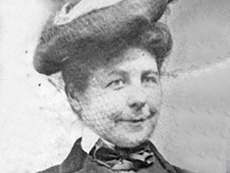Women at the Wheel
At the turn of the century, a woman’s place was in the home. But the automobile helped change that by setting women on the road toward greater freedom and work opportunity. Check out this timeline of automotive history highlights, design and technological firsts, that put American women in the driver’s seat.
1902 — Mary Anderson invented the first windshield wiper.

1906 — While both companies pioneered early marketing efforts geared toward women drivers, Baker Motor Vehicle Company eclipsed Detroit Electric as the largest electric vehicle maker in the world.

1909 — In part to prove a woman’s competence behind the wheel, 22-year-old Alice Ramsey became the first woman to drive across the United States.
1912 — With the invention of the self-starter, Charles Kettering finally made obsolete the biggest deterrent keeping women from driving — the arm-busting crank start.

1916 — The Girl Scouts initiated an “Automobiling Badge” for girls demonstrating driving skill, auto mechanics and first-aid skills.
1922 — Henry Ford opened Phoenix Mill and began hiring widows and single women, promising to pay women the same as men “so they could dress attractively and get married.”
1935 — William Stout invented a “mobile office” vehicle he calls the Scarab. Believed to be “too radical and modern for its time,” only nine Scarabs — what many contend is the first true “minivan”— were ever produced.
1943 — Helene Rother joined the interior styling staff of General Motors and became the first woman to work as an automotive designer.
1954 — Nash introduced the Metropolitan, a “commuter/shopping car” and the first American car marketed specifically to women.

1955 — Dodge introduced the La Femme, a pink, two-door coupe for women, featuring a matching calf-skin purse complete with coordinated accessories including a face-powder compact, lipstick case, cigarette case, comb, cigarette lighter and change purse.
1964 — While Ford would later reposition the vehicle as a muscle-car, Ford’s release of the Mustang began with a large marketing effort aimed at women.
1984 — After GM’s failed attempt to capture the “minivan market” in 1960 with the Corvair Greenbrier, Chrysler finally became America’s leading minivan maker with its release of the Dodge Caravan and Plymouth Voyager.
1995 — During an election for Denver city council, Susan B. Casey ran with the slogan “A Soccer Mom for City Council.” The term “soccer mom” (referring to married, middle-class, suburban mothers who drive minivans or SUVs) became part of the American lexicon and a powerful voting block courted by politicians.



Loved this “historical” info on women and cars. I do remember the Caravan being on display at the Louisiana World Exposition in New Orleans. We had two very small children at the time and driving a Datsun 210 Hatchback. I saw the Caravan and said, “Wow! This is so roomy!” It wasn’t until 1995 and three children later that we bought our own used 1991 Dodge Caravan. Many years of family ravels with the children in that van provided much pleasure thanks to Dodge’s innovation.